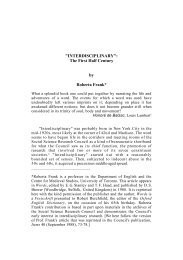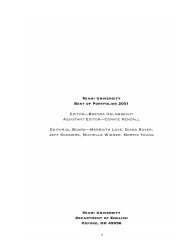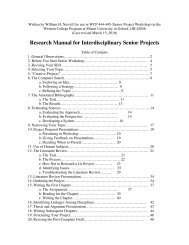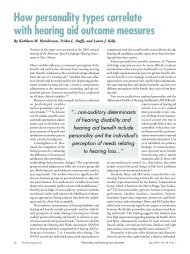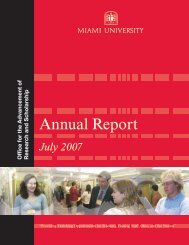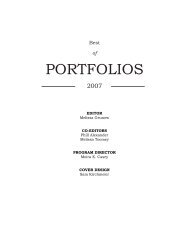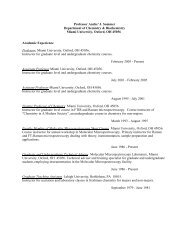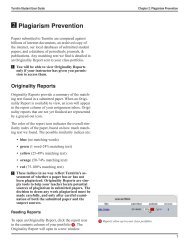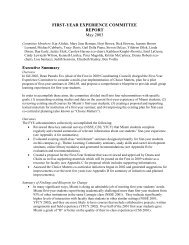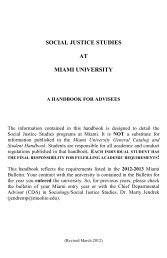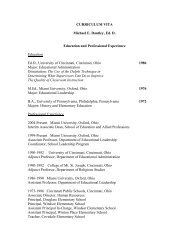The Steppes: Crucible of Eurasia - units.muohio.edu - Miami University
The Steppes: Crucible of Eurasia - units.muohio.edu - Miami University
The Steppes: Crucible of Eurasia - units.muohio.edu - Miami University
You also want an ePaper? Increase the reach of your titles
YUMPU automatically turns print PDFs into web optimized ePapers that Google loves.
Katheryn M. Linduff, Department <strong>of</strong> Anthropology and Department <strong>of</strong> the History <strong>of</strong> Art and<br />
Architecture, <strong>University</strong> <strong>of</strong> Pittsburgh (linduff@pitt.<strong>edu</strong>)<br />
Belt Buckles: Metallurgical and Iconographic Markers <strong>of</strong> Distinction<br />
Four thousand years ago cultures emerged in the area known variously as eastern <strong>Eurasia</strong>,<br />
Inner Asia, the beifang (北方), the Northern Zone, or the Northern Frontier. Delineated by<br />
Chinese historians <strong>of</strong> the second century BCE and later as a never-never land, they gave these<br />
peoples various names that marked them with a heritage distinct from peoples in the Dynastic<br />
heartland. So troublesome was this area for the dynasts, that they eventually set up a system <strong>of</strong><br />
‘border states’ and walls in their north that acted as a political, economic, cultural and military<br />
barrier reef meant to protect the ‘civilized’, agricultural states to their south.<br />
<strong>The</strong> signs <strong>of</strong> this separation were marked as well with lightweight and portable artifacts<br />
used in the beifang—small in scale but intricate in design—including belt plaques, appliqués for<br />
clothing as well as accompanying horse gear, bits, strap crossers and bridle ornaments and<br />
including chariot and cart fittings in gold, silver and bronze. <strong>The</strong>se were neither Chinese nor<br />
steppic in type or aesthetic, but rather were inspired by both models. <strong>The</strong>se pieces bear motifs <strong>of</strong><br />
the wild animals and birds <strong>of</strong> prey that inhabited the region—tigers, boar, deer, ibex—and<br />
including some domesticates such as camels, horses, donkeys and yaks. Even swords and knives<br />
bear animal ornamentation on their hilts and pommels. <strong>The</strong>se were created for the local<br />
inhabitants and the market, and most <strong>of</strong>ten in Chinese foundries, as best as we can tell. <strong>The</strong>y<br />
have <strong>of</strong>ten been thought to document a mobile lifeway, although that notion is rethought here.<br />
Study <strong>of</strong> the metallographic and casting technology used to produce these materials not<br />
only <strong>of</strong>fers a way to learn about their unique character, but also to discern distinctive cultural<br />
patterns and the process <strong>of</strong> interregional exchange in the region that led to their creation. Belt<br />
plaques, which I will particularly address here, were a very special category—not merely<br />
decorative, but given their final resting place in burial; their special types and iconography; their<br />
resourceful means <strong>of</strong> production; and their elaboration with inset semi-precious stones and<br />
gilding or silvering, marked them for special use. By the end <strong>of</strong> the first millennium BCE, they<br />
were in great demand in many areas <strong>of</strong> <strong>Eurasia</strong> and both the metallurgical and iconographic<br />
content are distinctive residue <strong>of</strong> invention as a result <strong>of</strong> culture contact and exchange. At the<br />
frontiers <strong>of</strong> the Chinese and Xiongnu Empires, they had become practicable signs <strong>of</strong> inter and<br />
intra community differentiation.<br />
Kenneth Lymer, Wessex Archaeology Ltd, Salisbury, UK (k.lymer@wessexarch.co.uk)<br />
Animals Entangled in Art: <strong>The</strong> Lives <strong>of</strong> Zoomorphic Imagery in Central Asia during the 1st<br />
Millennium BCE<br />
<strong>The</strong> art <strong>of</strong> early nomadic archaeological cultures that roamed the steppes <strong>of</strong> <strong>Eurasia</strong><br />
during the 1st millennium BCE is characterised as exhibiting predominantly zoomorphic imagery,<br />
the so-called Scytho-Siberian ‘animal style’. Moreover, it could be said that the concept <strong>of</strong> the<br />
‘animal style’ was born in Central Asian academic studies. O.M. Dalton in his monograph on the<br />
Oxus Treasure (1905) found objects recovered from what is known today as Tajikistan had a<br />
style similar to known Scythian objects recovered from the regions around the Black Sea.<br />
Furthermore, Dalton found this ‘Scythic art’ was also based upon animal decorative forms and<br />
held a uniform canon <strong>of</strong> taste that was an unmistakable characteristic <strong>of</strong> the cultures ranging<br />
from the Yenisei river to the Carpathians. <strong>The</strong> actual coining <strong>of</strong> the ‘animal style’, however,<br />
8



